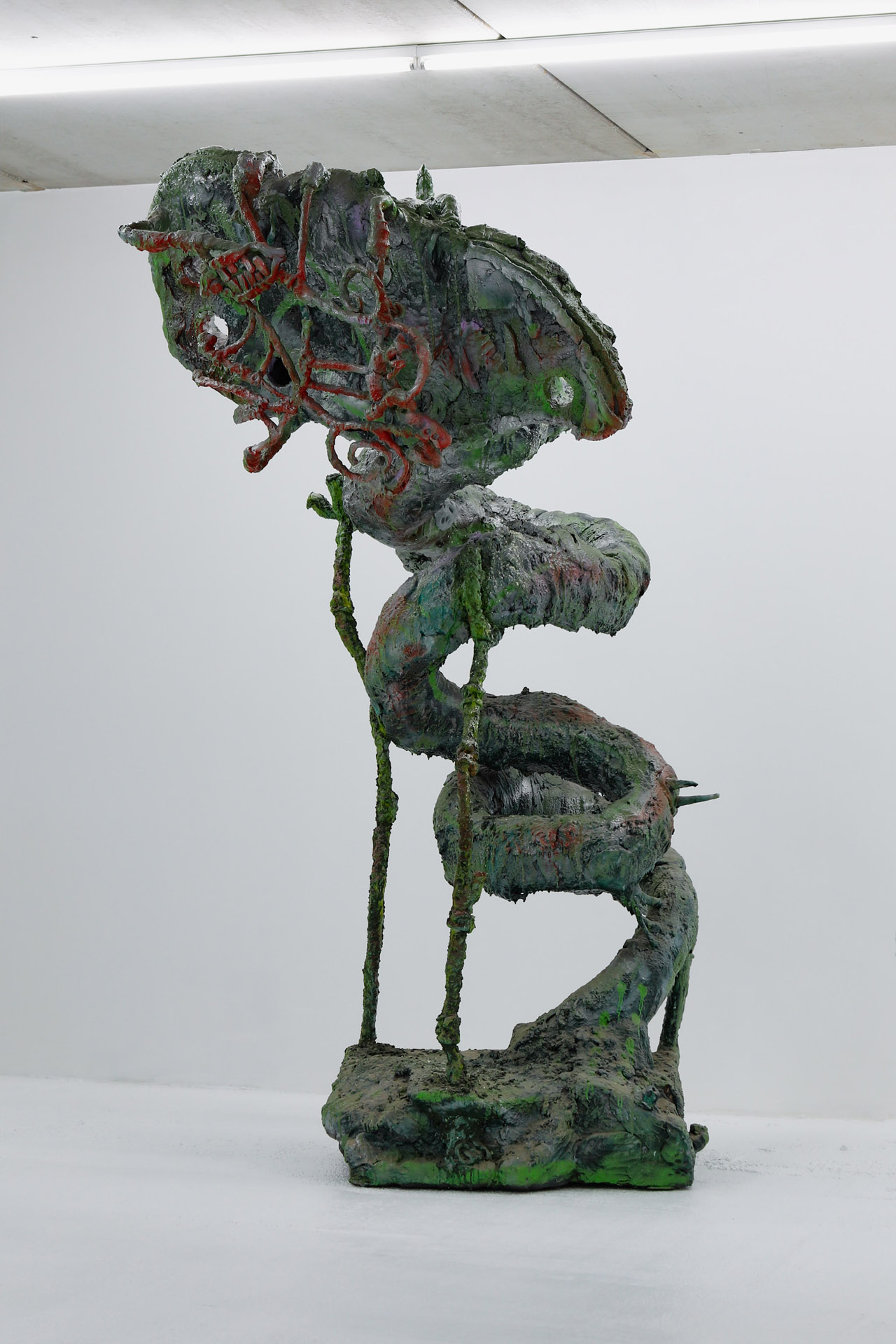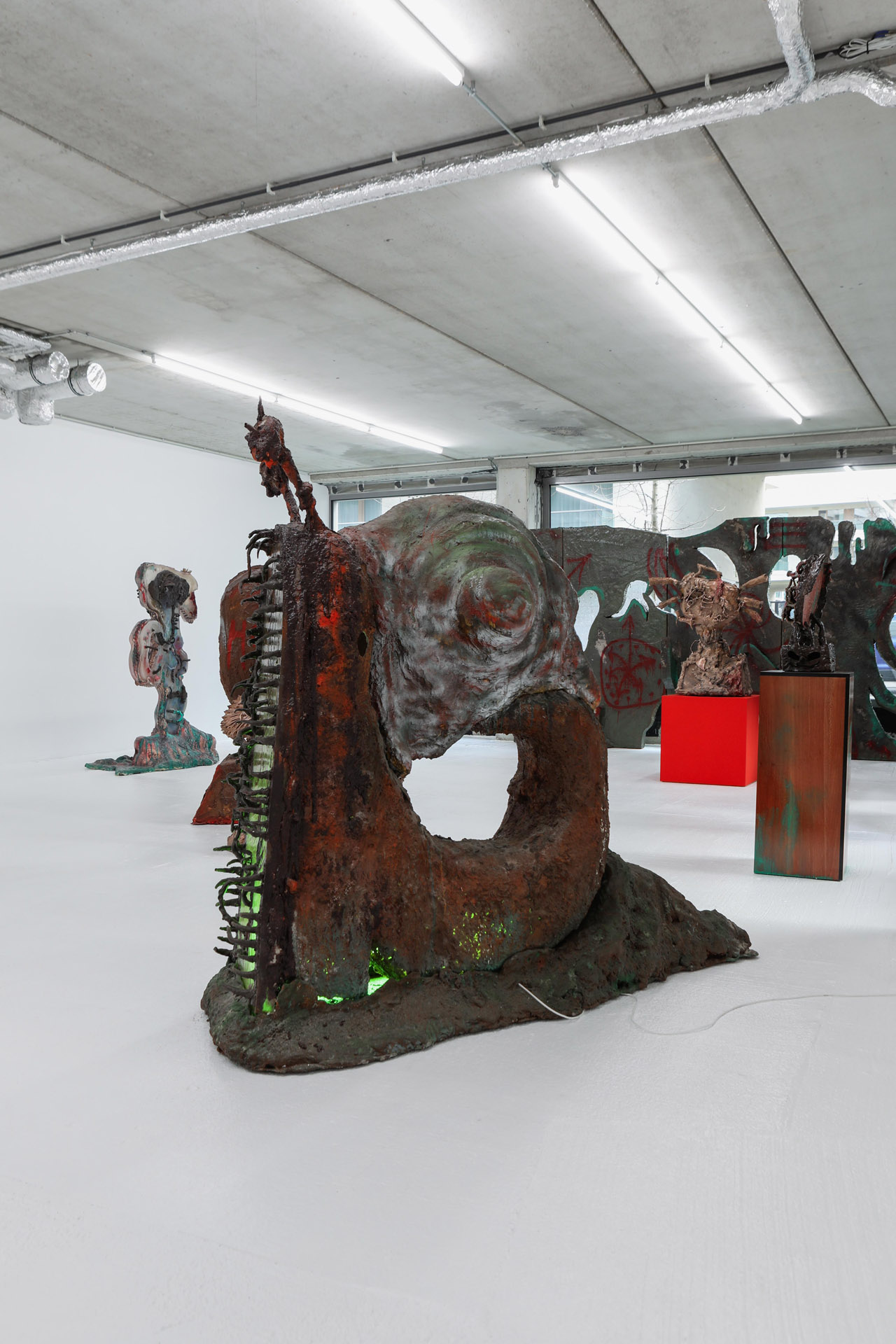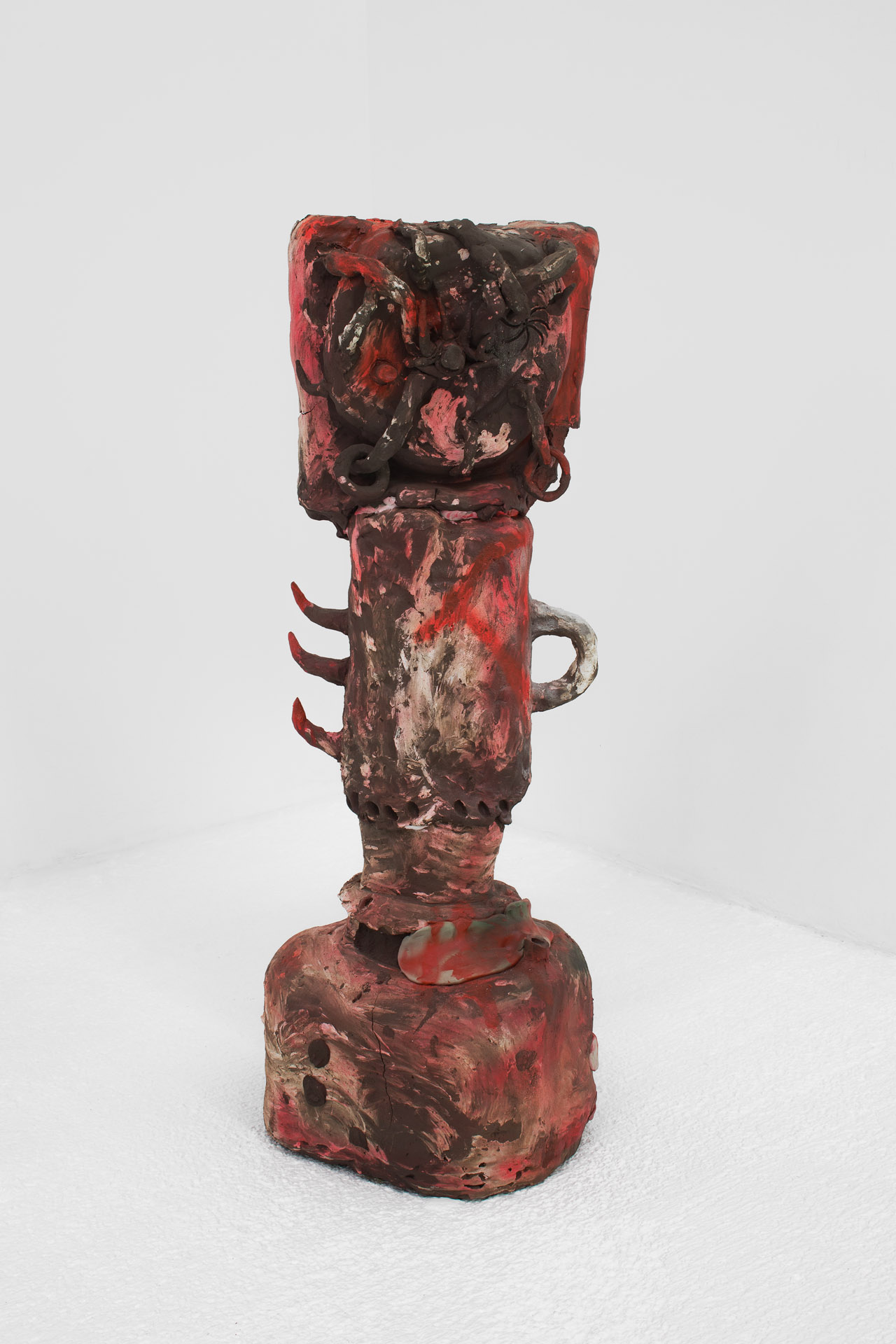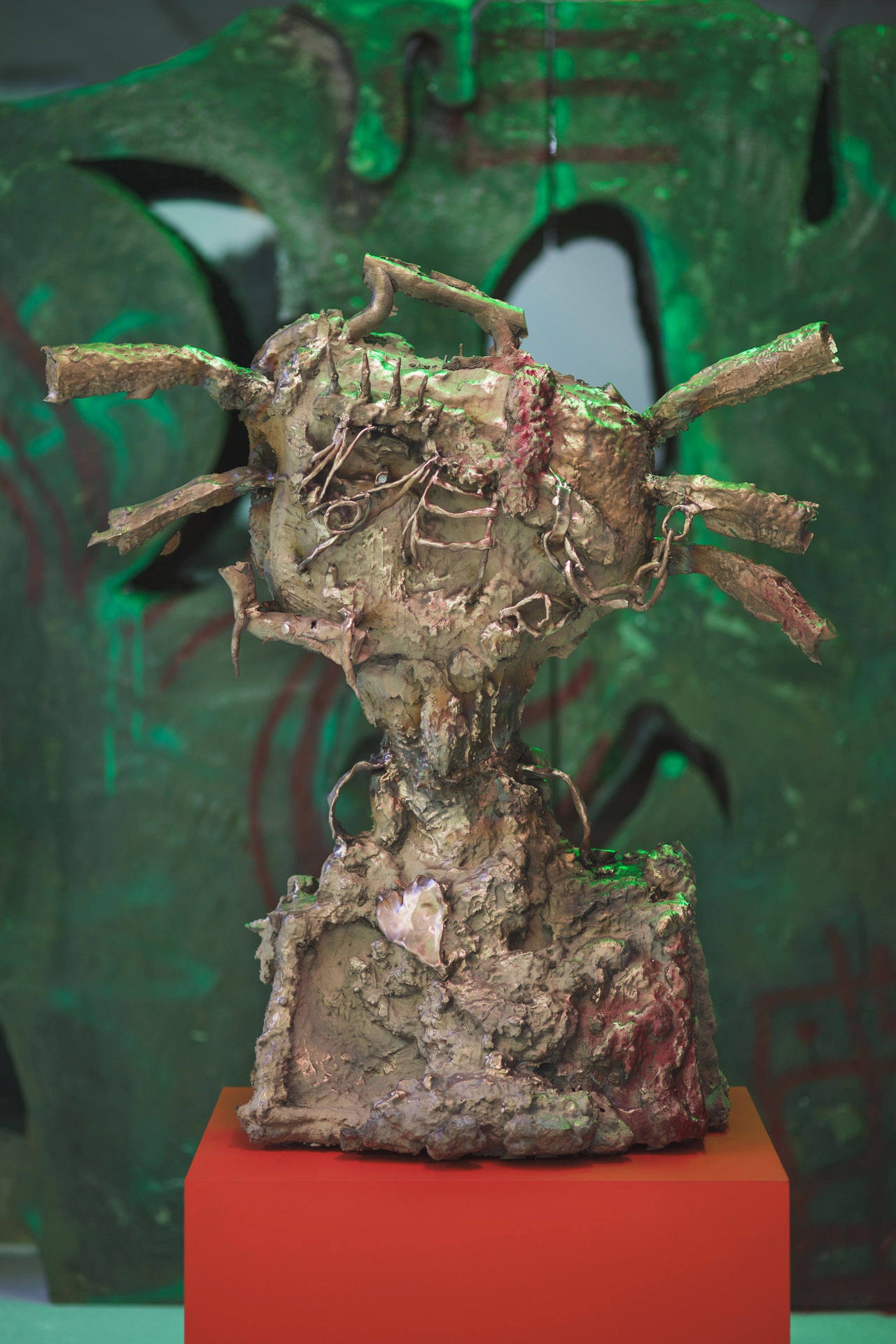Artist: Tom Volkaert
Exhibition title: As slow as possible
Venue: Everyday Gallery, Antwerp, Belgium
Date: January 30 – March 13, 2021
Photography: Silvia Cappellari, Seppe Elewaut / all images copyright and courtesy of the artist and Everyday Gallery, Antwerp
Tom Volkaert’s sculptural work is a testimony to the materiality of memory as much as it is an ongoing tribute to the spiritual and shamanic force of art.
Born in Antwerp in 1989, Volkaert’s sculptural work is a carefully balanced combination of refined artistic craftsmanship and the strategic use of unpredictability that comes into play when working with enameled ceramics, epoxy, or oxidized metal. Many of his works consist of circles on legs, which the artist likes to call steering-wheels. These works are like totems: symbolic and organic artifacts that make present the otherworldly alien life in the cosmos and that put us in touch with something radically different from us. On the edges and inside these circles, contorted arachnoid limbs, intestines, and sickly satanic tongues are carefully arranged and held in suspended animation. It is as if these circles are portals to another cosmic dimension and something wholly other than human life is trying to get through, a lumpy otherworldly and alienated organic gesturing at us in a way that feels both familiar and estranging.
But Volkaert’s so-called steering wheels are also a totem for his own life and memories, a way of navigating and coming to terms with his own life. For Volkaert, colors embody memory. Personal memories first of all. And thus, the lived memory of the cinereous cigarette stains on the caput morteem colored carpet in his parent’s living room is reenacted and relived through the use of these colors in his work. But universal memories too. The usage of umbilical greyish pink and placenta-colored red appeal to a birthing process all of us have gone through; engaging with these colors, Volkaert’s sculptures establish a connection to the matrixial mother in which all creativity is situated, making the viewer receptive to the most intimate and estranging experience of being alive.
Conjuring up these contradictory feelings and holding them together is, ultimately, at the core of Volkaert’s artistic practice. Holding together contradictory sensations, his art opens a space where feelings of joy, surprise, wonder, and disgust are enclosed in the same ceramic totem or metal cut-out or epoxy statues.
Two artists. Two exhibitions. Two formal languages. Tom Volkaert’s sculptures are made from epoxy and steel and it is their size that makes them impressive. Gielis’ bronze and ceramic figurines, on the other hand, are intriguing precisely because of their introverted smallness. Gielis’ sharply defined neon sculptures are almost repulsive due to their appealing colors. Volkaert’s amorphous shapes and steel cut-outs are appealing because of their repulsive color schemes.
And yet: in spite of the apparent difference between the formal language of Gielis and Volkaert, these artists share an attitude; or even what one might call a counter-language.
What might a counter-language be? The visual language that Gielis and Volkaert have each developed in their own way often refers to an underground culture that escapes the mainstream of the art world.
Skate and hardcore in the work of Gielis, obscure gore and old sci-fi B-movies in the work of Volkaert. The many references to these subcultures can be understood as multitimbral voices that oppose and escape the dominant traditions of the art world. However, the real meaning and expressiveness that Gielis and Volkaert derive from these references only emerge once they are positioned within the interpretative field of the art world. It is only when interacting with a community of viewers for whom this visual language and references take on a new and artistic dimension that they truly become part of a work of art. This is the moment that meaning becomes unstable: we both recognize the underground references and are also unable to grasp them fully. As a result, these works acquire enigmatic quality.
Paradoxically, to achieve this effect Gielis and Volkaert need to let go of – and perhaps even betraying – the underground they so cherish. And at the same time, betrayal is always lurking in the art world too; after all, this world not only consists of an intimate community of viewers, but also exists (and even originated) from commerce.
In the work they created together and that brings the two exhibitions together, Gielis and Volkaert describe this paradox as «haat voor het veld (hatred for the field)». But let here be no mistake: this is also about self-hatred; about hatred for how the art world is being eaten up by the art market, and hatred for how the artists themselves are trapped in that world. The red neon letters of Haat voor de Veld (2020) somehow neutralize and obliviate the toxic, spit-green colored pool in the background – just as Gielis and Volkaert’s art pushes away the underground culture that they thrive upon, and vice versa.
Still, hate is certainly not at the core of these two exhibitions. On the contrary. Underneath the hatred we find determination and vulnerability. Volkaert’s giant snail moves as slowly as possible and carries its own world on its back, extremely vulnerable but always ready to withdraw into its own shell and wait patiently. The old man of Gielis, drags the world behind him like a heavy burden, melancholic and crutching his shoulders. Incredibly slow, the old man moves on, and so does the world in his wake. It is as if Gielis and Volkaert are saying that in spite of all the hatred, art carries this world and makes living in it bearable.
Text by Bram Ieven
Tom Volkaert, As slow as possible, 2021, exhibition view, Everyday Gallery, Antwerp
Tom Volkaert, As slow as possible, 2021, exhibition view, Everyday Gallery, Antwerp
Tom Volkaert, As slow as possible, 2021, exhibition view, Everyday Gallery, Antwerp
Tom Volkaert, As slow as possible, 2021, exhibition view, Everyday Gallery, Antwerp
Tom Volkaert, As slow as possible, 2021, exhibition view, Everyday Gallery, Antwerp
Tom Volkaert, As slow as possible, 2021, exhibition view, Everyday Gallery, Antwerp
Tom Volkaert, As slow as possible, 2021, exhibition view, Everyday Gallery, Antwerp
Tom Volkaert, As Fast As Possible, 2019, Epoxy resin, spray paint, TL-light, H 190 x W 210 x D 75 cm
Tom Volkaert, Big thing, 2019, Epoxy resin, spray paint, H 305 x W 130 x D 125 cm
Tom Volkaert, As slow as possible, 2021, exhibition view, Everyday Gallery, Antwerp
Tom Volkaert, As slow as possible, 2021, exhibition view, Everyday Gallery, Antwerp
Tom Volkaert, Haat Voor Het Veld, 2019, Tom Volkaert and Daan Gielis, Neon, epoxy resin, wood
Tom Volkaert, Untitled IV, 2021, Drawing, H 35 x W 26 x D 3,5 cm
Tom Volkaert, Untitled III, 2021, Drawing, H 35 x W 26 x D 3,5 cm
Tom Volkaert, Second option but always my first choice, 2020, Ceramics, spraypaint, epoxy putty, H 107 x W 40 x D 40 cm
Tom Volkaert, Artisticus Confusa, 2020, Bronze (Edition 1 of 5), H 90 x W 40 x D 40 cm
Tom Volkaert, Artisticus Confusa, 2020, Bronze (Edition 1 of 5), H 90 x W 40 x D 40 cm
Tom Volkaert, As Slow As Possible, 2020, Epoxy resin, ceramics, epoxy putty, spray paint, H 186 x W 145 x D 77 cm
Tom Volkaert, As slow as possible, 2021, exhibition view, Everyday Gallery, Antwerp
Tom Volkaert, I’m here for my family, I’m here for my friends, I’m here for you, 2020, Bronze, spray paint, H 102 x W 112 x D 62 cm


























